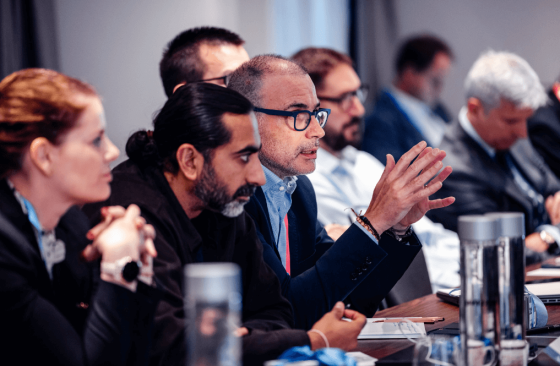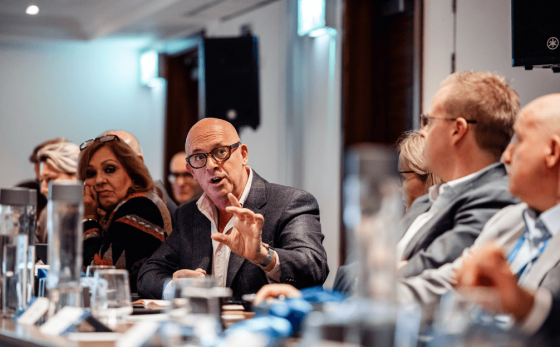A roundtable discussion is a structured conversation where participants sit to share ideas, opinions, or expertise on a specific topic. Key characteristics include open dialogue, equal participation, and collaborative problem-solving. They're used for brainstorming, decision-making, and knowledge sharing.
Not every event needs a stage and a spotlight. Sometimes, the real breakthroughs happen when people sit at the same level—literally. And that’s the idea behind roundtable discussions.
Roundtable discussions are small, focused conversations that get everyone engaged and talking. They aim to exchange insights, solve problems, and build relationships that outlast the event. These events are intimate and structured and bring the right people together for meaningful conversations.
In this guide, we’ll look at what roundtable discussions are, how to plan and host them, and how technology can support a smooth experience, whether the event is in-person or virtual.
What is a roundtable discussion?
A roundtable discussion is a type of micro event where a group of participants explores a specific topic. Each person is given the space to contribute, respond, and build on others’ ideas. Unlike traditional presentations, participants share their input and collaboratively think during these discussions.
Most of the participants are typically peers or stakeholders who share a common interest or challenge. The roundtable discussion format works well for internal leadership conversations, industry-focused breakouts, or customer advisory sessions. Everyone at the table is expected to engage and not just sit back and listen.
Roundtable meetings are most effective when the group is kept small, typically between six and twelve people. This allows the conversation to flow naturally and gives everyone enough time to speak. The setting may be formal or informal, but the purpose remains the same: bringing the right people into a room to exchange ideas in a focused and meaningful way.
How to host a roundtable discussion: 6 easy steps
Careful planning is behind every productive business roundtable. Follow these steps to ensure the conversation stays focused and everyone gets value from the experience.
1. Define the purpose
Start planning a roundtable discussion with a clear reason. What topic needs discussion, and what kind of input are you hoping to gather? Maybe it’s pressure-testing a new strategy, surfacing customer pain points, or aligning different teams on a shared goal. The more specific the purpose, the easier it becomes to structure the conversation and measure its effectiveness.
2. Choose the right participants
Who’s at the table will shape the outcome. Aim for 6 to 12 people who have something meaningful to contribute. They don’t need the same job titles or viewpoints, but they should share a connection to the issue at hand. The best roundtables mix experience with perspective and leave out anyone who’s unlikely to speak.
3. Assign a strong moderator
A moderator’s job is to guide, not control. They introduce the topic, keep things moving, and step in when the discussion veers off-track or gets dominated by one voice. They also notice who hasn’t spoken and make space for them to jump in. Choose someone who’s comfortable navigating group dynamics and won’t hesitate to redirect if needed.
4. Prepare a discussion flow
Good conversations don’t necessarily need rigid agendas, but they do need shape. A short structure—welcome, context, discussion, and wrap-up—can give people a rhythm to follow. Share a few open-ended prompts or guiding questions ahead of time so attendees can come prepared to engage rather than improvise.
5. Set the stage
Logistics influence participation. In-person, round, or oval tables work best so everyone can see each other clearly. For virtual roundtable discussions, select a platform that ensures equal screen visibility and provides reliable audio. Keep the group small enough that people don’t have to compete to be heard. Distractions, such as bad lighting, echo, and noise, can quickly kill momentum.
6. Capture takeaways
You don’t need a transcript, but you do need a record. Assign someone to jot down meeting minutes, key points, action items, and unanswered questions. Send a summary afterward so the insights don’t disappear the moment the meeting ends.
Planning for effective roundtable discussions
The best roundtables don’t start at the table. They begin weeks in advance, during the planning process. When done well, this preparation shows up in how naturally the conversation flows, how thoughtful the participation is, and how clearly the outcomes are defined.
Before the event
1. Choose a focused topic
Every roundtable starts with a question worth discussing. It needs to be relevant enough that people care and focused enough that they can respond to it without wandering in circles. When the topic is too broad, the session turns into a string of unrelated opinions. When it’s too narrow, people hold back because they’re not sure they’re the right voice in the room. The sweet spot is a themethat invites input from multiple perspectives without losing direction.
2. Invite the right mix of people
There’s no room for passive attendees at a roundtable. Everyone should have a reason to be there, and something to offer. That might be a specific perspective, experience with the issue, or a role in deciding what happens next. The group doesn’t need to agree, but they should be interested in the topic. They should also be able to speak openly with one another. That’s where the best conversations happen.
3. Give people a reason to show up ready
No one enjoys being caught off guard in a group setting. Send a short note before the session with a few lines about the topic, what kind of conversation you’re aiming for, and how long they’ll be in the room. Add a couple of open-ended prompts if needed. It’s to make sure the room doesn’t go quiet while people try to find their footing.
During the roundtable
4. Open with clarity
Start the session by reminding everyone why they’re there. A quick reintroduction of the topic, followed by names around the table, is usually enough. The goal is to give enough context to make everyone feel like they’re part of something purposeful.
5. Keep the conversation balanced
It’s the moderator’s job to watch the flow of time and voices. They make sure no one voice takes over and that everyone has a chance to contribute. Sometimes, that means stepping in when the discussion stalls. Other times, it means stepping back and letting the room work through something. Either way, the moderator sets the pace without becoming the focus.
After the roundtable
6. Summarize the discussion
Once the session ends, don’t let the insights disappear. Assign someone to take notes and create a clear summary of the key ideas, questions raised, and any common themes that emerged. Sharing this recap with participants gives them something to revisit and shows that their input was taken seriously.
7. Share outcomes (Even if they’re small)
Not every roundtable ends in a decision, but there should still be a clear next step. It could be a follow-up session, a shift in internal priorities, or a message back to the group explaining what will happen with the insights shared. People are more likely to join future sessions when they see their contributions lead somewhere.
8. Stay connected
Roundtables often bring together people who don’t usually meet, and that’s part of their value. After the event, consider whether there’s an opportunity to keep that conversation going, whether through a shared doc, a group thread, or a future invitation. Even a simple thank-you note can keep the line open.
9. Stay close to the topic
Roundtables work best when the conversation stays anchored. That doesn’t mean forcing it into a tight agenda. But if the group starts drifting into unrelated areas, it’s helpful to bring them back to the central question. A single comment, “Let’s come back to the original point,” is often enough to reset the focus without breaking the flow.
How technology supports roundtable planning
Planning a roundtable may seem simple on paper—fewer people, no stage, and a straightforward agenda. However, it’s exactly that intimacy that makes execution more challenging. Everyone in the room needs to know why they’re there. The invites need to be tight. The remindershave to go out on time. And once the session starts, the focus should stay on the conversation and not on troubleshooting a sign-in link or trying to remember who RSVP’d.
That’s where the right tech can make a difference. Technology can automate most of these tasks and keep the whole experience consistent. From managing invites and registration to collecting post-event feedback, software can help planners stay ahead of the details without having to do everything manually. It also reduces room for error, so sessions start on time, with the right people present, and follow-ups don’t get lost.
This support becomes even more important in hybrid and virtual setups. You can’t rely on body language or casual side talk to guide the room. The experience needs to be structured by design—clean handoffs, smooth transitions, and built-in ways for participants to engage, even if they’re not physically there.
At scale, tech also helps repeat what works. If a roundtable format resonates, the same framework can be reused across regions, teams, or customer groups without needing to start from scratch each time. Maintaining that kind of consistency can be hard with spreadsheets and standalone tools. But with the right platform, it’s baked in.
This was one of the key takeaways from a recent episode of the Great Events podcast, where the hosts talked about how repeatable, scalable event formats—like roundtables—become the foundation for event-led growth. They also made it clear: just because something is small or consistent doesn’t mean it’s simple. Getting the right people in the room, customizing content, and justifying ROI for high-frequency event programs takes serious work. That’s exactly where the right tools and workflows make the difference.
Why Cvent Essentials works across every roundtable format
Roundtables don’t always look the same. Some happen face-to-face in boardrooms. Others are virtual, with participants joining from different countries. Sometimes, they’re hybrid, with a handful of people around the table, the rest on screen. But no matter the format, the core logistics don’t change. You still need to invite the right people, track responses, send reminders, and ensure the event runs without friction.
Cvent Essentials is perfect for such high-volume field marketing events that need to stay organized without demanding the overhead of a full-scale conference platform. Whether your roundtable is happening online or on-site, Essentials provides a clean registration flow, a branded landing page, and automated confirmations.
If you’re planning an in-person discussion, you can manage check-ins using QR codes and view attendance in real-time. If it’s virtual, the platform supports live engagement through polling and Q&A. Hybrid events don’t need workarounds either; attendee types can be managed in one place, with separate experiences built in.
Beyond the logistics, this field marketing software gives you control over how people interact during and after the session. You can collect feedback immediately, see engagement data as the event unfolds, and export everything without switching tools. It allows you to run tight, consistent events that still feel personal.
And if you’re not just running one roundtable, but ten, or twenty, across different teams or regions, Essentials doesn’t slow you down. Once the first session is set up, you can duplicate the structure with a few clicks.
Every new roundtable maintains the same brand experience, workflows, and data fields. That consistency matters, especially when you’re working across functions or reporting back to stakeholders who need clean numbers and clear outcomes. Essentials handles the setup, the process, and the wrap-up so you can focus on the conversation, not the coordination.
Closing thoughts
Roundtable discussions only work when they’re planned with care. That means knowing what the session is about, who should be in the room, and how to make the most of the time people are giving you. Nothing should feel improvised.
For most planners, content is the priority. In fact, 38% say meeting content is the most important part of the attendee experience. In a roundtable, that content comes from the people in the room. The format just needs to support it without getting in the way.
Frequently asked questions
1. What is the purpose of a roundtable?
A roundtable is a meeting of a small group of people to discuss a specific topic. It’s meant to be collaborative and different from panel discussions, seminars, or any other internal events. Everyone is expected to contribute, and the goal is to learn from the group rather than just share individual opinions.
2. What is the difference between a roundtable and a panel discussion?
The key difference is participation. A panel discussion is a one-way format: a few speakers share their views while an audience listens. Panel discussions are often hosted for visibility and knowledge sharing, not interaction. A roundtable, on the other hand, has no audience. Everyone at the table is involved. The value comes from dialogue, not presentation. Panelists prepare remarks. Roundtable participants prepare to think on their feet and engage with others directly.
3. How do you prepare for a roundtable discussion?
Start by understanding why the roundtable is being held: what topic is on the table, and what kind of input the organizers are hoping to gather. If pre-event materials or prompts are shared, go through them carefully. Think about what you’ve seen in your work that relates to the topic, and come ready to contribute. You don’t need to prepare slides or talking points, but you should be ready to speak honestly, ask questions, and build on what others say. It’s not about being right. It’s about moving the conversation forward.
Up next, read 10 creative internal event ideas to boost employee engagement.










